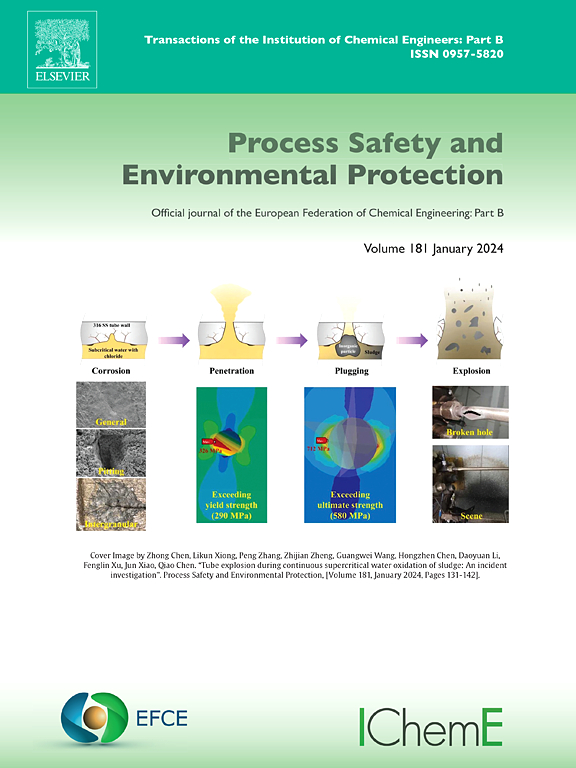A novel early warning method for thermal runaway of lithium-ion batteries based on mechanical stress signal
IF 6.9
2区 环境科学与生态学
Q1 ENGINEERING, CHEMICAL
引用次数: 0
Abstract
Thermal runaway constitutes a critical safety hazard in lithium-ion batteries, posing substantial risks to both human and property safety. Therefore, early warning is essential for mitigating these risks. Current monitoring strategies predominantly rely on voltage, current, temperature, and gas signals. However, these parameters exhibit limitations: electrical signals (voltage and current) and temperature demonstrate fluctuations significantly only before thermal runaway, while gas detection becomes feasible only after the opening of safety valve. These constraints result in insufficient warning time. This study systematically investigates the mechanical stress evolution and distribution on the surface of 280 Ah lithium iron phosphate batteries during overheating-induced thermal runaway across various stages of charge. The stress evolution is divided into four stages: exponential growth, linear growth, abrupt drop, and rebound. Subsequently, the underlying mechanisms driving each stage are elucidated through comprehensive analysis of thermal runaway. Notably, we established an innovative early warning method by identifying the transition point from exponential to linear growth, enabling thermal runaway prediction over 30基于机械应力信号的锂离子电池热失控预警新方法
热失控是锂离子电池的重要安全隐患,对人身和财产安全构成重大风险。因此,早期预警对于减轻这些风险至关重要。目前的监测策略主要依赖于电压、电流、温度和气体信号。然而,这些参数存在局限性:电信号(电压和电流)和温度只有在热失控之前才会出现显著波动,而气体检测只有在安全阀打开后才可行。这些限制导致预警时间不足。本文系统地研究了280 Ah磷酸铁锂电池过热热失控过程中不同充电阶段表面机械应力的演化和分布。应力演化可分为指数增长、线性增长、突然下降和反弹四个阶段。随后,通过对热失控的综合分析,阐明了驱动各阶段的潜在机制。值得注意的是,我们建立了一种创新的预警方法,通过识别指数增长到线性增长的过渡点,可以提前30分钟预测热失控,这也是在安全阀打开之前。此外,分析了安全阀开启时的应力分布规律,为优化压力传感器的放置提供了指导,从而降低了实施成本。
本文章由计算机程序翻译,如有差异,请以英文原文为准。
求助全文
约1分钟内获得全文
求助全文
来源期刊

Process Safety and Environmental Protection
环境科学-工程:化工
CiteScore
11.40
自引率
15.40%
发文量
929
审稿时长
8.0 months
期刊介绍:
The Process Safety and Environmental Protection (PSEP) journal is a leading international publication that focuses on the publication of high-quality, original research papers in the field of engineering, specifically those related to the safety of industrial processes and environmental protection. The journal encourages submissions that present new developments in safety and environmental aspects, particularly those that show how research findings can be applied in process engineering design and practice.
PSEP is particularly interested in research that brings fresh perspectives to established engineering principles, identifies unsolved problems, or suggests directions for future research. The journal also values contributions that push the boundaries of traditional engineering and welcomes multidisciplinary papers.
PSEP's articles are abstracted and indexed by a range of databases and services, which helps to ensure that the journal's research is accessible and recognized in the academic and professional communities. These databases include ANTE, Chemical Abstracts, Chemical Hazards in Industry, Current Contents, Elsevier Engineering Information database, Pascal Francis, Web of Science, Scopus, Engineering Information Database EnCompass LIT (Elsevier), and INSPEC. This wide coverage facilitates the dissemination of the journal's content to a global audience interested in process safety and environmental engineering.
 求助内容:
求助内容: 应助结果提醒方式:
应助结果提醒方式:


